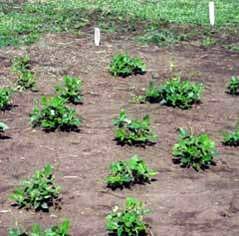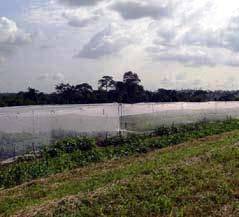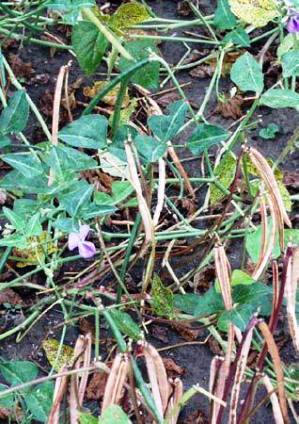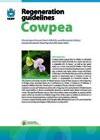Regeneration guidelines for cowpea
|
View regeneration guidelines in full (in PDF) Also available in the following languages: |
The information on this page was extracted from:
Dumet D., Adeleke R. and Faloye B. 2008. Regeneration guidelines: cowpea. In: Dulloo M.E., Thormann I., Jorge M.A. and Hanson J., editors. Crop specific regeneration guidelines [CD-ROM]. CGIAR System-wide Genetic Resource Programme, Rome, Italy. 8 pp.
Before reading the regeneration details for this crop, read the general introduction that gives general guidelines to follow by clicking here.
Introduction
Cowpea (Vigna unguiculata (L.) Walp.) is cultivated around the world primarily as a pulse but also as a vegetable (for its leaves as well as the green peas), as a cover crop and for fodder. It has many common names including blackeyed pea, crowder pea, southern pea, lubia, niebe, coupe and frijole. It belongs to the family Fabaceae and its cultivated species V. unguiculata (syn. V. sinensis (L.) Savi ex Hassk., V. sesquipedalis (L.) Fruwirth) include 11 sub species and a large number of related species, many of them grown as minor legumes or forage crops. Amongst these are V. subterranea (L.) Verdc., V. radiata (L.) R. Wilczek, V. angularis (Willd.) Ohwi & H. Ohashi and V. umbellata (Thunb.) Ohwi & H. Ohashi.
Cowpea is an annual herbaceous plant with a large tap root and alternate trifoliate leaves with ovate leaflets. It shows considerable diversity in growth habit, flower and seed coat colour. The standard flowers vary in colour from white, cream and yellow to purple and the seeds, which are smooth or wrinkled, range from white, cream or yellow to red, brown or black and are characterized by a marked hilum surrounded by a dark aril.
Cowpea is regenerated by seeds and is largely self pollinating but up to 2% outcrossing has been reported (Ng and Hughes 1998; Fatokun and Ng 2007).

Cowpea at flowering. (photo: Jean Hanson/ILRI) |
Choice of environment and planting season
Climatic conditions
- The environment most similar to that of the collection site is generally considered optimum. Cultivated cowpea varieties are adapted to hot and dry conditions. They grow best at low altitudes with a precipitation of about 1000–1200 mm and temperatures between 22° and 30°C over 6 months.
- Cowpea does not tolerate excessively wet conditions, cold or frost.
Planting season
- Plant during rainy seasons or in dry seasons with irrigation.
Preparation for regeneration
When to regenerate
- When insufficient seeds or plant propagules are available for conservation or distribution.
- After viability loss in storage, when percentage germination drops below 75%.
Pre-treatments
- Cowpea, like all legumes, forms a symbiotic relationship with a specific soil bacterium (Rhizobium spp.). Although cowpea Rhizobium is normally widespread, innoculating seed with Rhizobium specific to cowpea would be beneficial in areas where it is not present (Davis et al. 1992).
- Pre-treat seeds with a fungicide (e.g. Mencozeb coating) before planting.
Field selection and preparation
- Cowpea grows best on a sandy loam with a pH close to neutral, with good drainage on flat land and gentle slopes. It also tolerates acid and alkaline soils.
- Plough, harrow and ridge soil before sowing.
Method of regeneration

Spacing at planting. (photo: Jean Hanson/ILRI) |
Planting
Planting layout, density and distance (see photo)
- Sow 80 seeds (a minimum of 50 seeds) per accession in two 4-m rows (40 seeds per row), with 75 cm between rows.
- Sow two seeds per hole, 2–3 cm deep and make holes 20 cm apart.
- Plant two border lines of cowpea as a growth control.
- Using the above layout, you can maintain an average 1333 accessions per ha.
Sowing method
- The normal sowing method is direct planting.
- Alternatively, for accessions with very few seeds or poor germination, germinate seeds in an incubator and sow in pots in a screenhouse/greenhouse; move to the field as small plants (at least 5–6 nodes on the main stem).
Isolation method
- Place pol ination cages (see photo) at flower bud initiation stage during ful regeneration.
- Keep 50 accessions per cage.
- Use netting with 3 mm mesh or smaller.
- Alternatively, use spatial isolation with a distance of at least 20 m, and preferably 50 m, between accessions.

Pollination cages for geneflow control. (photo: IITA genebank) |
Labelling
- Label each row with a weather-resistant tag fastened to a stake about 1m high.
Crop management
Weed management
- Weeding frequency will depend on rate of growth of the weeds and their density. On average, weeding two or three times may be required during the growing season.
Irrigation
- Irrigation is required in the dry season, 2 to 4 hours twice a week with a sprinkler.
Fertilization
- As a legume, cowpea fixes its own nitrogen and thus does not need nitrogen fertilizer.
- Apply phosphate fertilizer: single super phosphate (SSP) at 60 kg/ha or triple super phosphate (TSP) at 25 kg/ha.
Common pests and diseases
Contact plant health experts to identify the symptoms of the likely pests and diseases and the appropriate control measures. The following eight insect-transmitted viruses are reported to be seed-borne in cowpea (Ng and Hughes 1998):
- Cowpea yellow mosaic comovirus, CYMV (beetle)
- Cowpea aphid-borne mosaic potyvirus, CABMV (aphid)
- Blackeye cowpea mosaic potyvirus, BlCMV (aphid)
- Cowpea mottle (carmo) virus, CPMoV (beetle)
- Cucumber mosaic cucumovirus, CMV (aphid)
- Southern bean mosaic sobemovirus, SBMV (beetle)
- Cowpea mild mottle carlavirus, CPMMV (whitefly)
- Sunn-hemp mosaic tobamovirus, SHMV
Major pests attacking cowpea are flower thrips (Megalurothrips sjostedti), legume pod borer (Maruca vitrata) and a number of pod sucking insects.
Pest and disease control
- It is good practice to carry out regeneration in insect-proof conditions, but this may be impractical under the scale of regeneration required.
- Follow recommendations provided by your plant health expert to prevent and control pests and diseases during regeneration.
Other
- Plants showing disease symptoms, or different flower colour or shape compared with the overall population, should be eliminated.

Mature pods, ready for harvesting. (photo: Jean Hanson/ILRI) |
Harvesting
- Harvest seeds from all plants to ensure retention of genetic integrity of the original accession (Ng and Hughes 1998).
- As a general principle, take an equal number of seeds from the largest possible number of maternal plants in order to keep the effective population size (Ne) as high as possible (Vencovsky and Crossa 1999).
- Harvest pods when 95% in one accession have turned yellowish brown (see photo).
- The approximate time of harvest in the field is 60 to 120 days after planting but it depends on the maturity of the plants.
- Harvest pods by hand when they are dry and keep them in net bags.
Post-harvest management
Seed processing
- Pre-dry pods under shade (in a glasshouse if possible).
- Thresh pods either by hand or using a threshing machine.
- Clean seeds with a blower or by hand (depending on seed quantity).
- Fumigate seeds to reduce pests and diseases only if there are signs of insect attacks.
- Note that this is, however, not generally recommended for long-term storage.
- Perform a final hand cleaning and conformity check (with original seed sample) to eliminate obvious alien seeds.
- Dry seeds in a drying room (RH=10–15%, temperature=16–18°C) for 4 to 10 weeks, i.e. until optimal water content is reached (7–8% for cowpea). If a drying room is not available, dry seeds to a moisture content of 7–8% with silica gel or another appropriate desiccant.
- Germinate seeds on germination paper in a polyethylene box at 20–30°C (20 seeds per accession).
- Determine seed moisture content (gravimetric) by fresh and dry weight after dehydration in oven at 80–110°C for 24 hours, 20 seeds per accession and/or with a seed moisture reader.
- Store seeds in plastic boxes at 5–8°C for medium-term storage and under vacuum in laminated aluminium foil for long-term storage (-20°C).
Monitoring accession identity
Keep an original seed sample in a small plastic bag in a dry environment at 15°C. Whenever the accession is regenerated, you can match the newly harvested seed to the seed sample. Confirm the regenerated seed accessions by comparing them with the following traits in the original characterization data:
- Flower characteristics
- Days to flowering
- Plant type (erect/semi erect/spreading/climbing)
- Days to maturity
- Pod colour
Documentation of information during regeneration
The following information should be collected during regeneration:
- Accession number
- Regeneration site name and map/GPS reference
- Field layout used; field/plot/nursery/glasshouse reference
- Environmental conditions, e.g. altitude, precipitation, soil type (only if not using usual regeneration site)
- Sowing date
- Number of seeds sown
- Field management details (watering, fertilizer, weeding, pest and disease control, stresses recorded, other)
- Emergence in the field or green house (number of plants germinated)
- Number of plants established
- Days from sowing to flowering
- Days to maturity (when 95% mature on same accession)
- Pollination control (method, number of plants pollinated)
- Date of first harvest and method
- Date of final harvest
- Number of plants harvested
- Quantity of seeds harvested
- Agronomic evaluation; agro-morphological traits recorded (if needed)
- Comparisons with reference materials (record any identification numbers or references of any samples taken from the regeneration plot)
- Post harvest (describe any relevant procedures)
References and further reading
Bioversity International, NBPGR, IITA. 2010. Key access and utilization descriptors for cowpea genetic resources. Bioversity International, Rome, Italy; National Bureau of Plant Genetic Resources, India; International Institute of Tropical Agriculture, Nigeria. Available here.
Davis DW, Oelke EA, Oplinger ES, Doll JD, Hanson CV, Putnam DH. 1992. Cowpea. Alternative field crop manual. University of Wisconsin, University of Minnesota. Available from: http://www.hort.purdue.edu/newcrop/afcm/cowpea.html. Date accessed: 12 March 2008.
Fatokun CA, Ng Q. 2007. Outcrossing in cowpea. Journal of Food, Agriculture and Environment 5:334–338.
Ng NQ, Hughes Jd’A. 1998. Theoretical and practical considerations in the regeneration of cowpea germplasm at IITA. In: Engels JMM and Ramanatha RR, editors. Regeneration of seed crops and their wild relatives. Proceedings of a consultation meeting, 4–7 December 1995, ICRISAT, Hyderabad, India. IPGRI, Rome, Italy. pp 76–80. Available here.
Vencovsky R, Crossa J. 1999. Variance effective population size under mixed self and random mating with applications to genetic conservation of species. Crop Science 39:1282–1294.
Acknowledgement
These guidelines have been peer reviewed by Jean Hanson, International Livestock Research Institute (ILRI), Ethiopia, and Remy Pasquet, International Centre of Insect Physiology and Ecology (ICIPE/IRD), Kenya.
Comments
- No comments found






Leave your comments
Post comment as a guest